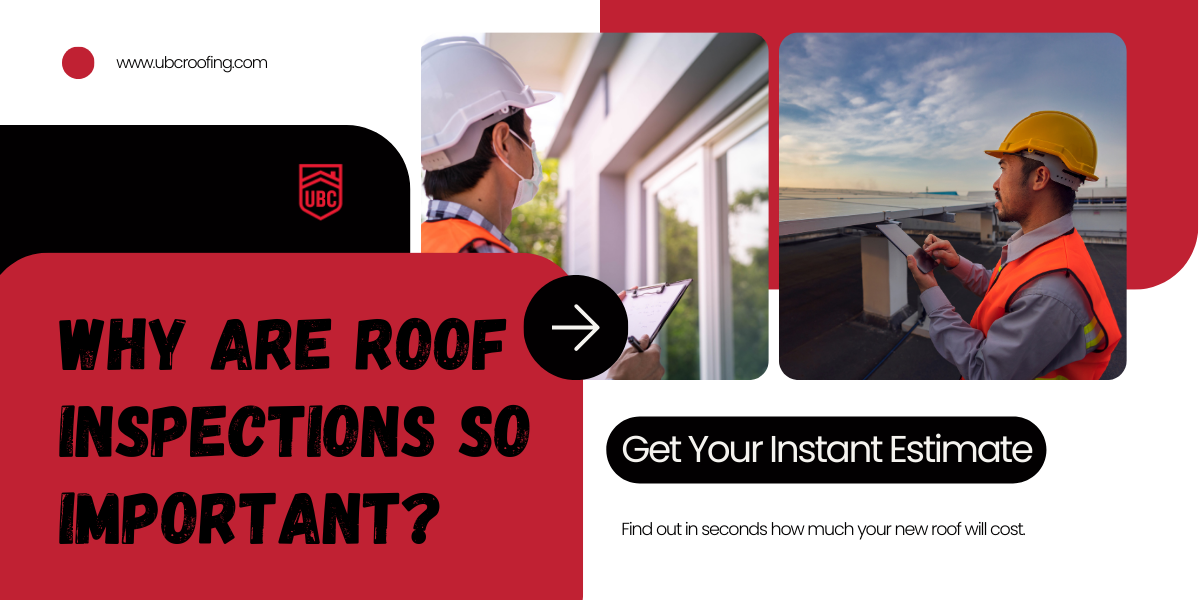Why Are Roof Inspections So Important?
Your roof is your home’s primary defense against the elements, protecting your property from rain, snow, wind, and sun. Regular maintenance and timely repairs are crucial to ensure its longevity and effectiveness in safeguarding your home. A well-maintained roof not only protects your home’s structure but also contributes to energy efficiency and overall property value. Investing in professional roof inspections and addressing issues promptly can save you from costly repairs and extend the life of your roof.
The Critical Role of Roof Inspections in Home Maintenance
Roof inspections play a vital role in preserving the integrity of your home. These assessments go beyond a simple visual check, providing valuable insights into the health of your roofing system. Here’s why they’re so crucial:
- Early Problem Detection: Regular inspections can identify minor issues before they escalate into major, costly repairs.
- Extended Roof Lifespan: Proper maintenance, guided by inspection findings, can significantly extend your roof’s life expectancy.
- Energy Efficiency: A well-maintained roof contributes to better insulation and reduced energy costs.
- Safety Assurance: Inspections can reveal structural issues that might pose safety risks to your family.
- Insurance Compliance: Many insurance policies require regular roof inspections to maintain coverage.
What Does a Professional Roof Inspection Entail?
Exterior Examination
- Shingle condition assessment
- Flashing inspection around chimneys, vents, and skylights
- Gutter and downspout evaluation
- Check for signs of moss, algae, or fungal growth
Interior Inspection
- Attic ventilation assessment
- Examination for signs of water damage or leaks
- Structural integrity check of rafters and trusses
Advanced Diagnostic Techniques
- Infrared scanning for hidden moisture issues
- Drone inspections for hard-to-reach areas
The Consequences of Neglecting Roof Inspections
Failing to conduct regular roof inspections can lead to severe consequences:
- Water Damage: Undetected leaks can cause extensive damage to your home’s interior, leading to costly repairs.
- Structural Deterioration: Prolonged exposure to moisture can weaken your roof’s structure, potentially causing collapse in extreme cases.
- Decreased Property Value: A neglected roof can significantly reduce your home’s resale value.
- Higher Energy Bills: Damaged roofing can compromise your home’s insulation, resulting in increased heating and cooling costs.
- Health Hazards: Moisture intrusion can lead to mold growth, posing health risks to your family.
How Often Should You Schedule a Roof Inspection?
The frequency of roof inspections depends on several factors:
- Age of the Roof: Older roofs typically require more frequent inspections.
- Local Climate: Areas prone to severe weather may need more regular checks.
- Recent Extreme Weather Events: Schedule an inspection after major storms or hail.
As a general guideline:
- New roofs (0-5 years old): Every 3-5 years
- Mid-life roofs (5-10 years old): Every 2-3 years
- Older roofs (10+ years old): Annually
The Impact of Weather on Roof Inspections and Maintenance
Weather plays a vital role in both the frequency of roof inspections and the types of damage inspectors look for. Understanding how different weather conditions affect your roof can help you better protect your home:
Seasonal Inspection Considerations
Spring: Check for winter damage and prepare for summer heat.
- Look for ice dam damage and loose shingles.
- Assess gutters for proper drainage after spring rains.
Summer: Prepare for potential storms and assess heat damage.
- Check for UV damage and thermal splitting.
- Ensure proper attic ventilation to prevent heat buildup.
Fall: Prepare for winter and address any summer storm damage.
- Clear debris from gutters and downspouts.
- Check flashing around chimneys and vents.
Winter: Monitor for snow and ice buildup.
- Look for signs of ice dams forming.
- Check attic for proper insulation and ventilation.
Weather-Specific Roof Damage
- High Winds: Can lift and remove shingles, exposing underlayment.
- Heavy Rain: May reveal leaks and test the effectiveness of drainage systems.
- Hail: Can cause impact damage, reducing the lifespan of roofing materials.
- Snow and Ice: Create the risk of ice dams and put extra weight stress on the roof.
- Extreme Heat: Can cause shingles to crack, blister, or curl.
Understanding these weather-related factors emphasizes the importance of regular, season-specific roof inspections.
The Cost-Saving Potential of Regular Roof Inspections
Investing in regular roof inspections can lead to significant long-term savings:
- Preventive Maintenance: Addressing minor issues early prevents costly major repairs.
- Extended Roof Lifespan: Proper care can add years to your roof’s life, delaying the need for replacement.
- Energy Savings: A well-maintained roof contributes to better home insulation and reduced energy bills.
- Warranty Preservation: Many warranties require regular inspections to remain valid.
Roof Care Matters: Schedule Your Inspection Today
Regular roof inspections are a critical component of home maintenance, offering peace of mind and potential long-term savings. By identifying and addressing issues early, you protect your investment and ensure the safety and comfort of your family. Don’t wait for visible signs of damage – proactive care is key to a healthy, durable roof.
Ready to safeguard your home with a professional roof inspection? Contact United Building Contractors today to schedule your comprehensive roof assessment. Our experienced team is here to help you protect your home’s first line of defense and ensure your peace of mind for years to come.






